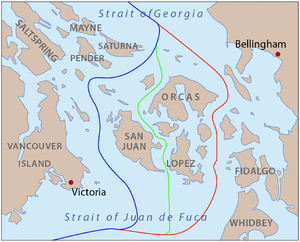Cutler, in his mid-twenties, arrived on the island that April after failing to stake a claim during the 1858 gold rush in British Columbia. According to the Skagit River Journal:
A contemporary described him as "one of the unwashed sovereigns of the United States who did not scare worth a cent". Another recalled he was "tall, light-haired fine looking, fearless, adventurous and full of fun." A third said he set up housekeeping with an Indian woman in a structure that was a cross between a tent and a hut.

(Hudson's Bay sheep farm on San Juan Island)
The pig was owned by Charles Griffin, who'd been hired by the British Hudson's Bay Company to run its sheep ranch on San Juan. Cutlar offered to pay Griffin $10 as compensation for the pig, but when Griffin demanded $100, Cutlar rescinded the offer. After British authorities threatened to arrest Cutlar, the farmer and his American neighbors called for American military protection.
Thirteen years to the day before Griffin's pig wandered into Cutlar's garden, the U.S. and Britain signed the Oregon Treaty, settling their conflicting claims in northwestern North America. America retained the lands that later became the states Oregon, Idaho and Washington while the lands further north, between the Rockies and the Pacific, were confirmed as British possessions.
 (from wikipedia)
(from wikipedia)For most of the territory in dispute the dividing line became the 49th Parallel but as it reached the Pacific it was described as:
"the middle of the channel which separates the continent from Vancouver Island, and thence southerly through the middle of the said channel, and of the Strait of Juan de Fuca, to the Pacific Ocean."The problem was that neither side had a firm grasp of the geography of the area. It turns out that there are two channels, one to the west, and one to the east, of San Juan Island which can be considered the middle channel. The result was both countries claimed sovereignty over the island.
 (from wikipedia)
(from wikipedia)In 1856 the two countries agreed to form a Boundary Commission to discuss disputes arising from the treaty, including the status of San Juan Island but by the end of 1857 the commission had failed to reach agreement and adjourned to report back to their respective governments.
It was during this period the Hudson Bay Company established its operation on the island and about 25 to 30 American settlers arrived and tensions were heightened between the two groups.
In response to the American settler request, the military dispatched Company D of the 9th Infantry Regiment stationed in Bellingham, along with its commanding captain, to San Juan Island. The captain was George S Pickett (the same man who attained immortality in the charge at Gettysburg that bears his name, on July 3, 1863).
Pickett had been transferred to the Washington Territory several years before and oversaw the construction of Fort Bellingham. While there he married Morning Mist, a member of the Haida tribe, who gave birth to a son before dying in 1858.
After arriving on San Juan on July 27, Pickett and the 60 or so men under his command established camp and began building fortifications to repell any attempted British landing. In response, three British warships anchored off the island, prompting yet more reinforcements to be sent by the Americans. Both sides were under orders not to fire first, but to resist if the other initiated combat.
By mid-August 461 American soldiers and 14 cannon were on the island, while offshore over 2,000 British with 70 cannon were aboard five warships.
The governor of Vancouver Island ordered Rear Admiral Robert Baynes to land naval marines on the island, but Baynes, fearing such an act would trigger open conflict, refused to do so.
As the standoff continued the atmosphere grew more relaxed. According to the National Park Service website San Juan Island National Historical Park:
While the Americans dug in, the British conducted drills with their 52 total guns, alternately hurling solid shot into the bluffs and raised rocks along Griffin Bay. It was all great fun for tourists arriving on excursion boats from Victoria, not to mention the officers from both sides who attended church serves together aboard the Satellite and shared whisky and cigars in Charles Griffin’s tidy home.When word of the strange and dangerous confrontation reached Washington and London both sides took steps to defuse the crisis. President Buchanan dispatched General Winfield Scott (commander of the U.S Army) to the northwest to negotiate with the governor of Vancouver Island. Reaching the area in October, Scott was quickly able to obtain agreement to a joint occupation of San Juan Island until such time as the two nations could reach a final settlement.
Under terms of the joint occupation both sides were limited to no more than 100 military personnel on the island. The occupation would continue until 1871 when Britain and the United States signed the Treaty of Washington, settling all outstanding disputes between the countries, including those arising from the Civil War. Among its provisions, the boundary dispute was referred to Emperor Wilhelm I of Germany to resolve the dispute by arbitration. The Emperor referred the matter to a three person arbitration commission in Geneva, Switzerland and in 1872 it awarded San Juan Island to the United States.
The joint occupation forces had an amicable relationship with frequent socializing and athletic competitions. The Americans invited their British counterparts to an annual July 4th celebration while the Brits hosted the Americans for an annual celebration of Queen Victoria's birthday.
Lyman Cutlar left the island sometime during the late 1860s and died on April 27, 1874.
thanks!
ReplyDelete